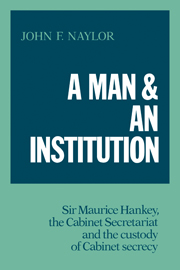 A Man and an Institution
A Man and an Institution Book contents
4 - The Secretariat in the 1920s: policies and procedures
Published online by Cambridge University Press: 30 March 2010
Summary
Hankey's presence at the first gathering of European statesmen in which Bonar Law took part led him privately to question the widely heralded distinction between the ways of Lloyd George and those of his successor:
Bonar Law is more tricky than I suspected … he asked to meet the Belgians (Theunis and Jaspar) alone, and asked them to Downing St., and for some reason he did not want Poincaré to know they were conspiring. (Vain thought! Foreigners always tell!) I met them all coming downstairs together. Theunis and Jaspar entered the Cabinet room by the usual entrance from the hall. Bonar came in through another door from the private secretary's room. Seeing M. Poincaré in the Cabinet room he turned to the Belgians (whom he had just left at the bottom of the stairs) and greeted them effusively, shaking them by the hand. And the Morning Post and other papers this morning are contrasting the ‘straightness’ of Bonar Law with the obliquity of Ll. G.! The latter would not have done this, I feel sure. It makes me suspect that Bonar was behind Warren Fisher all the time.
Despite his resentment with the recent treatment of the Cabinet Secretariat and his suspicions of his new Tory masters, Hankey soon came to their service in a fashion which demonstrated unequivocally the value of scrupulous record-keeping. His role was ironic, as it turned upon his defence of Curzon's past actions from an attack mounted by partisans of Lloyd George.
- Type
- Chapter
- Information
- A Man and an InstitutionSir Maurice Hankey, the Cabinet Secretariat and the Custody of Cabinet Secrecy, pp. 115 - 164Publisher: Cambridge University PressPrint publication year: 1984


